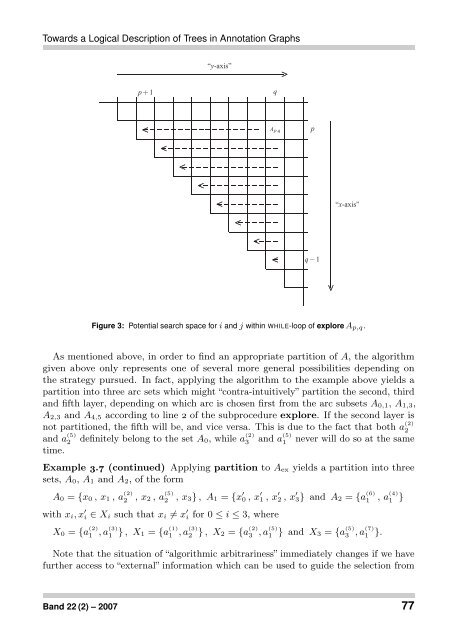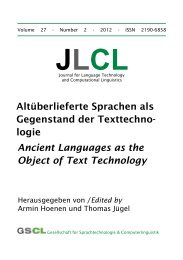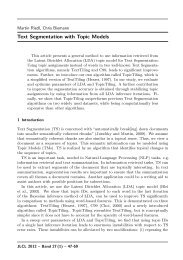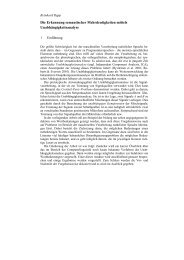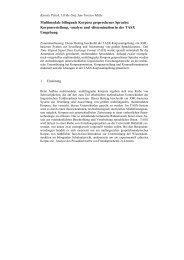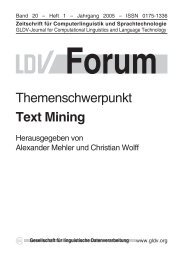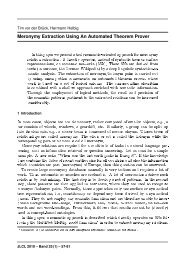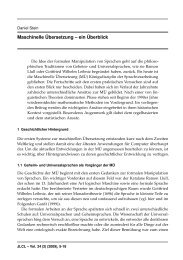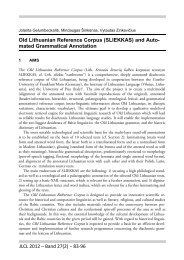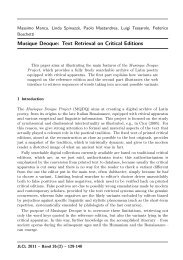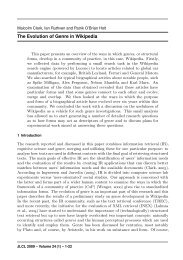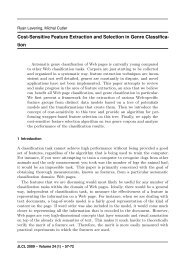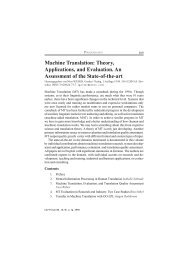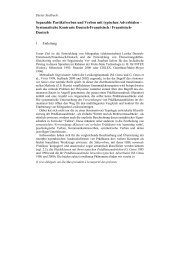Towards a Logical Description of Trees in Annotation Graphs - JLCL
Towards a Logical Description of Trees in Annotation Graphs - JLCL
Towards a Logical Description of Trees in Annotation Graphs - JLCL
You also want an ePaper? Increase the reach of your titles
YUMPU automatically turns print PDFs into web optimized ePapers that Google loves.
<strong>Towards</strong> a <strong>Logical</strong> <strong>Description</strong> <strong>of</strong> <strong>Trees</strong> <strong>in</strong> <strong>Annotation</strong> <strong>Graphs</strong><br />
“y-axis”<br />
∧<br />
p + 1<br />
q<br />
∧<br />
A p,q<br />
p<br />
∧<br />
∧<br />
∧<br />
∧<br />
“x-axis”<br />
∧<br />
∧<br />
∧<br />
q − 1<br />
∧<br />
Figure 3: Potential search space for i and j with<strong>in</strong> WHILE-loop <strong>of</strong> explore A p,q.<br />
As mentioned above, <strong>in</strong> order to f<strong>in</strong>d an appropriate partition <strong>of</strong> A, the algorithm<br />
given above only represents one <strong>of</strong> several more general possibilities depend<strong>in</strong>g on<br />
the strategy pursued. In fact, apply<strong>in</strong>g the algorithm to the example above yields a<br />
partition <strong>in</strong>to three arc sets which might “contra-<strong>in</strong>tuitively” partition the second, third<br />
and fifth layer, depend<strong>in</strong>g on which arc is chosen first from the arc subsets A 0,1, A 1,3,<br />
A 2,3 and A 4,5 accord<strong>in</strong>g to l<strong>in</strong>e 2 <strong>of</strong> the subprocedure explore. If the second layer is<br />
not partitioned, the fifth will be, and vice versa. This is due to the fact that both a (2)<br />
2<br />
and a (5)<br />
2 def<strong>in</strong>itely belong to the set A 0, while a (2)<br />
3 and a (5)<br />
1 never will do so at the same<br />
time.<br />
Example 3.7 (cont<strong>in</strong>ued) Apply<strong>in</strong>g partition to A ex yields a partition <strong>in</strong>to three<br />
sets, A 0, A 1 and A 2, <strong>of</strong> the form<br />
A 0 = {x 0 , x 1 , a (2)<br />
2 , x2 , a(5) 2 , x3} , A1 = {x′ 0 , x ′ 1 , x ′ 2 , x ′ 3} and A 2 = {a (6)<br />
1 , a(4) 1 }<br />
with x i, x ′ i ∈ X i such that x i ≠ x ′ i for 0 ≤ i ≤ 3, where<br />
X 0 = {a (2)<br />
1 , a(3) 1<br />
} , X1 = {a(1)<br />
1 , a(3) 2<br />
} , X2 = {a(2)<br />
3 , a(5) 1<br />
} and X3 = {a(5)<br />
3 , a(7)<br />
Note that the situation <strong>of</strong> “algorithmic arbitrar<strong>in</strong>ess” immediately changes if we have<br />
further access to “external” <strong>in</strong>formation which can be used to guide the selection from<br />
1 }.<br />
Band 22 (2) – 2007 77


